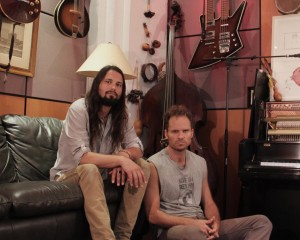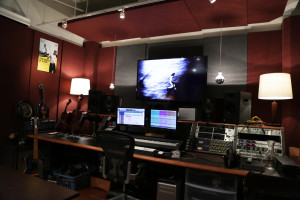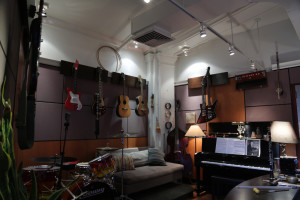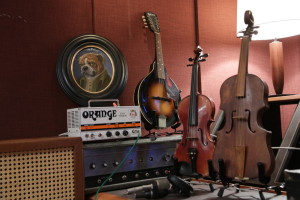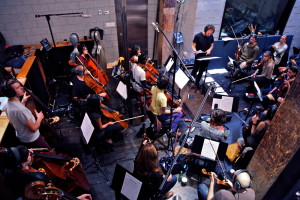Composer Cribs: NYC’s Stenfert Charles Takes the Tribeca Film Festival
With the Tribeca Film Festival tearing into Week 2, it’s good to know that home-grown talent is being heard on the soundtracks.
We refer to the music team known as Stenfert Charles – actually a prolific pair of composers named Danny Bensi and Saunder Jurriaans. On the same wavelength since fate brought them together nearly 20 years ago, they’ve been taking their own distinctive approach to music-for-picture since 2009.
The action in TriBeCa right now shows that their hitting their stride, with no fewer than three films sporting their sound: Franny, The Driftless Area, and A Faster Horse.
If you want to know why their reel is on a roll, read below – it’s a combo of chemistry, creativity, and technical sensibility that makes SF a duo worth knowing.
Composer Names: Danny Bensi and Saunder Jurriaans
Website: http://www.stenfertcharles.com
Location: East Village, Manhattan
Hear — and see — them at work for the soundtrack of Enemy, staring Jake Gyllenhaal, Melanie Laurent and Isabella Rossellini and directed by Denis Villeneuve.

Pairing Up: We met in Rhode Island in 1997, Danny’s best friend from high school was my roommate in college. Danny is a cellist and studied music though school and university. I am a guitarist and vocalist. We both play many other instruments also…. We hit it off immediately and would play music together whenever we got the chance. We both love epic music…from metal to Brahms to Shostakovich to Tango and beyond.
In 2001 we both moved to New York and started the band Priestbird (formerly Tarantula AD). We did a lot of touring and released five records. In 2009 Alistair Banks Griffin asked us to write the score for his film “Two Gates Of Sleep “. From there things just snowballed.
We have a very strong chemistry together and respect each other as musicians and as friends. We work a lot actually composing together but also we have designated times alone to write. It’s a huge pro to have another set of trusted ears on hand at all times, working on films can be a pretty exhausting and it’s easy to lose objectivity sometimes.
Soundtracks Served: We compose music primarily for films, documentaries, and shorts. We’ve done several TV documentaries as well. We also work on commercials and have composed for a multitude of high-end fashion videos.
Clients/Credits: We’ve had the honor of working on some great films and with great filmmakers. Here are some:
Martha Marcy May Marlene
Simon Killer
Magic Magic
Enemy
The One I Love
This year at Sundance:
Last Days In The Desert
The Wolfpack
Nasty Baby
Tribeca Film Festival 2015
Franny
The Driftless Area
A Faster Horse
Big Premiere: Our studio is part of Pulse Studios in downtown Manhattan. We moved in here 2011.
Room Inspiration: The room was already built out, but we modified it to make it comfortable and suit our needs as film composers. We had a good friend build some custom furniture including the tabletop and guitar hangers. We moved a piano in and loaded the place with instruments.
One of the most important things for us is the vibe. We spend a huge part of our lives in the studio so we’re constantly making sure to be surrounded by things that keep us inspired: Instruments, lighting, and artwork are key. We make sure to re-arrange the studio every few months as well to keep things fresh. We constantly have clients coming in as well so we want them to feel equally inspired and comfortable.
Key Personnel: Our assistant Chase Deso is a great musician and composer, technically savvy and a great guy. Chris Davies, the head engineer for Pulse Music Studios is also a great help for all sorts of things. JK (Joel Kipnis) the president of Pulse and Dan Kuby the manager have also been enormously helpful to us.
For larger orchestra recordings we put together our own orchestras and record at Gary’s Electric (part of Kemado Records) in Greenpoint. Tom Clapp is one of the owners and an old friend/collaborator of ours – as is Davey Jewel, the engineer, and the rest of the team over there!
Workflow Requirements: We are a pretty simple operation. We have a Pro Tools rig (we run Pro Tools 10 HD), and a couple of great microphones. We use a Coles 4038 ribbon mic for all of our string layering and a vintage Neumann KM 86i for almost everything else. We have two Focusrite ISA220’s and two Universal Audio LA 610’s.
One of the most important aspects for us is a really great, consistent signal. We do tons of layering so we try to keep things simple. We have the room set up so we can record anything – piano, cello, violin, guitar, percussion, etc… – really easily without having to move too much. Everything is on-hand at all times. We work pretty quickly and don’t like to be held up by long setups or change-overs.
Once you catch a wave, you don’t want to have to jump off because of technical issues. Capturing the right performance is way more important to us than a perfectly clean recording.
Picture This: We have a 60” Samsung LED (motion smoothing disabled!) and a couple of smaller monitors for edit and mixing windows.
Audience Accommodations: We have clients sit in the middle of the room so they can have the best soundscape and view of the screen. After all, they have to be just as creative and open-minded as us. Their feedback is crucial of course. We always have great chocolate and coffee on hand!
Complex Cue: The score for “Enemy” was very challenging at the time since it involved a huge amount of layers, a ton of experimenting and an orchestral recording. It was the first time we used an orchestra so we didn’t quite know what we were getting into!
We ended up booking the room at Gary’s Electric and the orchestra way early in the process and only really had one or two cues actually written at that point, we just had a bunch of melodic and textural ideas written out. We split the orchestra into sections – cellos and basses one day, violins and violas the next day, and brass the day after that.
We ended up with all these pieces that could be mixed and matched in all sorts of combinations, sort of a modular orchestra which we then brought back to our studio at Pulse and started to assemble. Using those orchestra recordings as beds we then tracked a ton of additional instruments in our room to glue everything together.
It was an amazing experience, we really pulled of a huge sound in a very un-traditional way.
NYC Scene: We’ve become friends with a great group of filmmakers in NYC. We see them all the time as the community is quite tightly knit around here – which is a good thing. The governing factor is that everyone is focused on making really creative and challenging films.
We’ve been really lucky to find a nice space at Pulse Studios where there are other composers working on all sorts of things. Having a community around you makes you feel more inspired to work and stay professional on a daily level.
Space may be the biggest challenge of working in NYC. Before Pulse studios, we were working out of one of our apartments in Brooklyn and if you listen closely to our early scores you can practically hear garbage trucks, sirens and loud people in the background! It’s hard to compare to LA since we haven’t spent enough time working there yet, but we know they’ve got some damn fine weather.
Priceless Advice: Try to start finding what it is you’re especially good at. Like what genre of music, or what instrument are you really good at, or mixing abilities, engineering, composition, etc. Get really into it and get really good at it.
Branch out from there. Just because you can recreate that Hans Zimmer score or that Cliff Martinez sound doesn’t make you a great composer. You have to be able to distinguish yourself.
Also, remember: less is more. Try going back and muting things all the time. Do you really need that extra octave or harmony in every string part?
— Saunder Jurriaans, Co-Founder, Stenfert Charles


Please note: When you buy products through links on this page, we may earn an affiliate commission.







